Menu
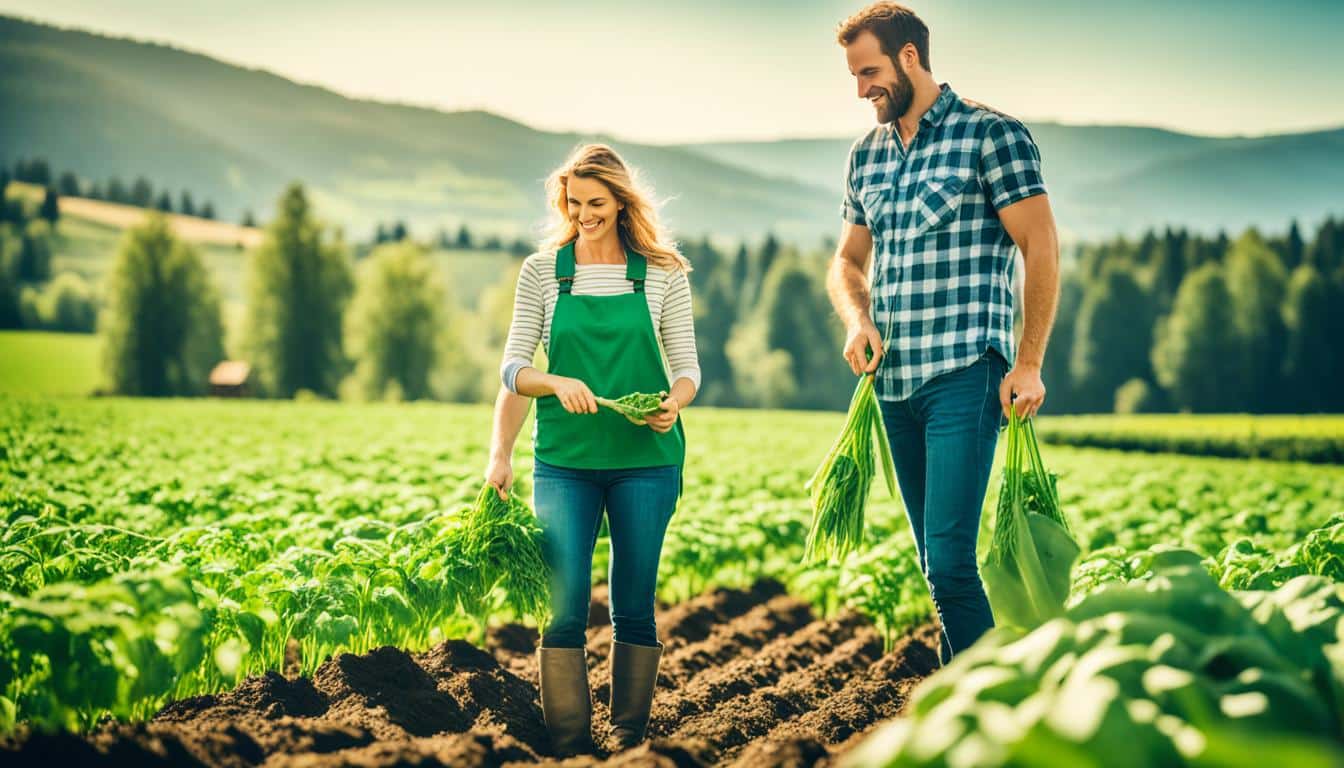
Did you know many readers of “ESG on Sunday” come from everywhere? This newsletter has grown in influence, even in Portuguese and Japanese. It shows ESG farming is a big deal worldwide. This approach can change how we see agriculture.
Farm CFOs now play a big role in making ESG part of financial planning. We want to use sustainable farming not just because rules ask us, but because people like it. Our goal is to mix ESG ideas into daily farming for better profits and stabler farming sectors.
ESG in farming deals with big nature problems like climate change and water issues. It also cares about how workers are treated. With ESG at the core, we can bring new ideas, manage risks better, and make investors happier.
As I lead towards a greener farming future, it’s tough but exciting work. We can make our farms and our communities understand the need for sustainability. This will make our farming future stronger and more thriving.
In recent years, the use of ESG principles in farming has become very important. They have a big impact on investment, with over $20 trillion following ESG and SRI. This shows how crucial sustainable and responsible farming is.
ESG is about looking at how well an organisation does in three key areas: the environment, society, and governance. In farming, ESG means using practices that are kind to the earth, treat workers fairly, and are ethical. This brings transparency and sustainability to agriculture, which many consumers want.
In the US, three-quarters of investors make choices based on their values. Companies focused on ESG are often more efficient. This is why ESG is becoming a key way to measure how well agriculture can last and grow.
ESG is vital in farming because agriculture impacts food safety and our planet. It accounts for a big part of global carbon emission, making it a major player in climate issues. Doing farming in a responsible way helps the environment and society.
For instance, vertical farming by Eden Green uses much less land and water. This helps cut down on emissions from shipping and makes better use of our resources. Hydroponic farming, with very little waste, also shows how fitting the ESG goals can be.
| Key ESG Metrics | Impact on Agriculture |
|---|---|
| Investment in ESG Funds | Outperforms competition in the medium to long term |
| Vertical Farming | Reduces land use by 99% and water use by 98% |
| Climate Impact | Agriculture sector accounts for 25% of global greenhouse gas emissions |
| Hydroponic Farming | Less than 3% food waste; promotes sustainable practices |
Living up to ESG standards helps farms keep up with new rules and meet what consumers want: sustainability. By talking to those interested and checking on how they’re doing, farms can really change things. This doesn’t just make better food, it also builds trust and faith from those who care.
It’s crucial to make farms more resilient to climate change. This is due to the rising threats from global warming. Since 2020, there’s been a big push from investors for more sustainable farming.
Being able to adapt is key to surviving climate change’s effects. It’s hard to keep up with all the ESG rules for farming. But, strategies that focus on saving soil and being green help a lot. This includes keeping the soil healthy, stopping deforestation, and controlling soil erosion. Also, it means ensuring good crop yields and water use.
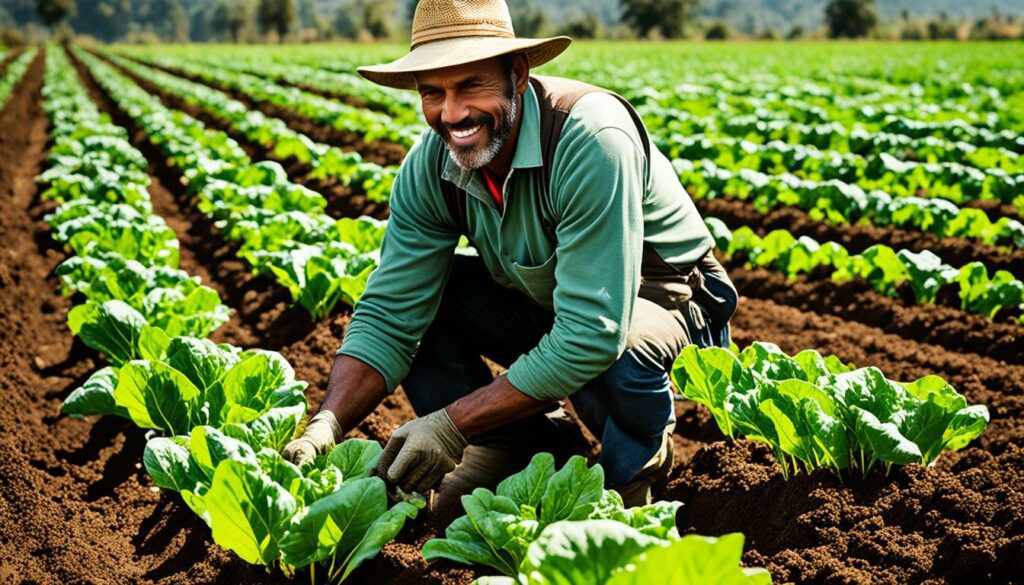
Now, things like equal rights, diversity, and a good work-life balance matter a lot. Being honest about the food we eat is also more important than ever. Businesses that care about these things are doing better and attracting the best people.
Investing in crops that can handle drought is crucial for future farming. Thanks to technology, we have made big strides in creating these crops. And, we have financial tools like green bonds to support sustainable farming.
| Climate Strategy | Impact |
|---|---|
| Drought-Resistant Crops | Sustains productivity during dry periods |
| Soil Carbon Sequestration | Mitigates climate change by storing carbon in the soil |
| Transparency Measures | Increases consumer trust and understanding |
Dealing with climate risk is now an urgent need for farms. They must be ready to bounce back fast from disasters. And, they have to start telling the world how they’re fighting climate change. Laws are getting tougher, making farmers include these strategies in their plans.
It all adds up to creating a farming future that can survive climate change. It means using smart strategies and investing in the right crops. This way, farms can keep producing and tick all the ESG boxes.
Sustainable resource management in agriculture is key to long-term productivity and taking care of our planet. There’s a growing interest in earth-friendly farming because of over $20 trillion in investments. We are focusing on using water wisely and keeping the soil healthy, which are crucial for sustainable farming. These steps help the environment and bring in good money.
Using water resources well is very important in farming. CFOs need to spend money on smart water technologies like drip irrigation. This way, water goes straight to the plants for less waste and better crop growth. This also protects our water sources and reduces pollution from excess water.
| Water Management Technique | Benefits |
|---|---|
| Drip Irrigation | Reduces water waste and increases crop yield |
| Water Recycling Systems | Conserves water and decreases operational costs |
| Precision Farming | Optimises water application, minimising runoffs |
Looking after our soil is another big part of sustainable farming. Things like crop rotation and less ploughing are vital. Crop rotation stops pests and makes the soil better, while less ploughing keeps the soil’s good bits and water. By using these methods, we keep our land fertile and avoid harming the environment.
Agribusinesses should also use cover crops and agroforestry to keep the soil healthy. These help with climate change and support a healthy farming method. Protecting the soil is crucial for farming to be both profitable and sustainable.
Biodiversity is key for healthy ecosystems and helps with sustainable farming. The World Economic Forum found that up to $44 trillion of value needs nature and its services. So, supporting biodiversity in farming is good for the planet and the pocket.

Biodiversity means the many life forms on Earth, from single species to whole ecosystems. Places with lots of different species can cope better with change and are stronger against harm. Businesses protecting biodiversity make our planet tougher and show they care about the future.
The 15th U.N. Biodiversity Conference set big goals for 2030, aiming to protect 30% of Earth’s land and waters, plus restore 30% of damaged areas.
Using integrated pest management (IPM) helps enhance biodiversity in farms. It focuses on using natural enemies to control pests instead of chemicals. It’s a step towards healthier ecosystems and farming that’s better for the environment.
Investing in biodiversity can include helping use nature carefully, improving tech to protect diversity, or fixing natural areas. More and more people in the U.S. are putting money into these biodiversity efforts, both in private and public sectors. This shows a growing belief in the economic and environmental benefits of protecting nature.
| Key Targets | Goals by 2030 |
|---|---|
| Protecting Earth’s Land and Waters | 30% |
| Reducing Global Food Waste | 50% |
| Restoring Degraded Lands and Waters | 30% |
| Phasing Out Harmful Subsidies | Complete Elimination |
Places with lots of biodiversity are better at surviving major problems like diseases and extreme weather. Companies with strong biodiversity plans are more attractive to investors who value sustainable farming. This shows that there are both financial and environmental benefits to keeping farming methods biodiverse.
The agricultural sector needs to reduce its carbon footprint fast. It must use renewable energy and ways to store carbon. Doing this not only helps fight climate change but also boosts profits.
Renewable energy is key in the fight against climate change. The way we grow our food has a big impact. Nearly a quarter of the world’s greenhouse gases come from how we use the land and the food supply chain.
Choosing solar, wind, and biogas over fossil fuels can cut emissions. It makes the carbon footprint smaller.
Using solar panels on farms can power irrigation, which cuts costs and emissions. Wind power can also provide electricity for other farm needs. These methods are good for the planet and save money too.
Another way to lower emissions is through carbon sequestration. Agroforestry, mixing trees with crops, traps carbon. It stores carbon in trees and soil, benefiting the climate and the environment.
Urban farming is also great at trapping carbon. In Seoul, it could cut 11.67 million kg of CO2 each year. This would meet 93% of Seoul’s vegetable needs.
And the yields would be higher than those in Australia, proving its effectiveness.
The table below shows how urban agriculture outperforms traditional farming:
| Aspect | Urban Agriculture | Traditional Farming |
|---|---|---|
| CO2 Emission Reduction | 11.67 million kg annually | Varies significantly |
| Yield per Square Meter | Double | Baseline |
| Vegetable Supply Capacity | 93% of Seoul’s needs | Depends on scale and technology |
By using these carbon capture methods, agriculture can be more sustainable. It also earns money through carbon credits. This shows a farm is looking to the future, a future that is green and profitable.
In farming today, using energy wisely is very important. It’s part of making sure farms are kind to our planet. When a farming business cares about energy, it spends less money on running and helps the Earth too.
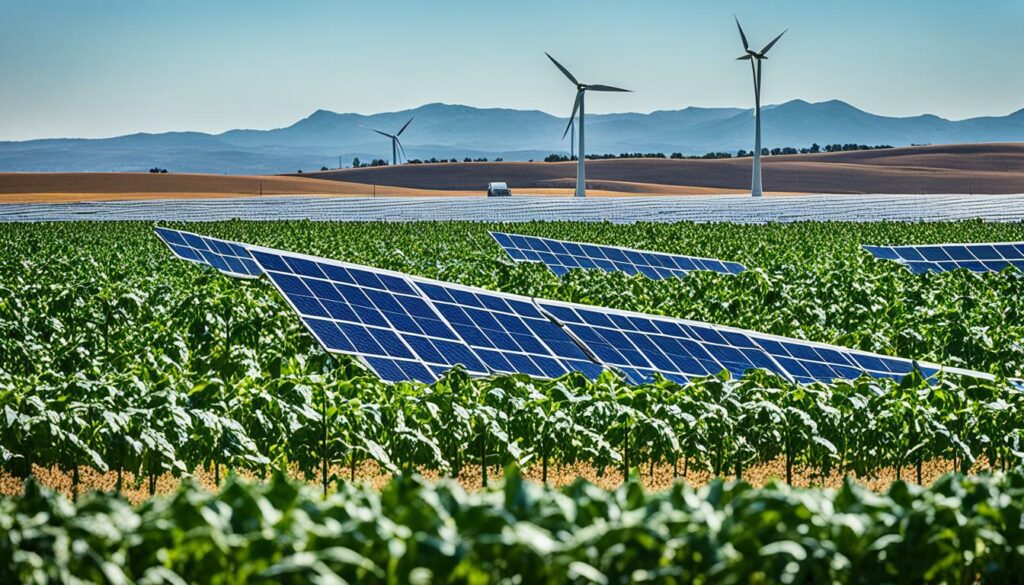
The agricultural sector is seeing over $20 trillion invested thanks to being environmentally friendly. A lot of American investors pick their investments based on what they believe is right. This shows a major interest in farming that’s both profitable and green.
Businesses aiming to be green and efficient do better than others. They make more profit and their value grows over time. For example, Eden Green Technology uses new farming methods that save a lot of land and water. They waste very little food this way.
Farming is now working hard to be more eco-friendly. They are reducing harmful gases, saving water, and cutting down on leftover food. By growing crops closer to where people live, they’re also keeping the air cleaner. These smart steps make farming not just better for the Earth, but also for us, the consumers.
Today, lots of farming businesses are using the latest tech to be smarter about the environment. They collect lots of data to do farming better using digital tools. This digital trend is growing. Investors are putting a huge amount of money into farming, expecting farms to be more green and efficient.
Choosing to be smart with energy in farming has many good effects. It makes a farm more trusted, safer, and attractive to those with money to invest. Businesses that care about energy now can do well in the future. They will meet the growing expectation for farms to be both green and successful.
Pollution control and waste management matter a lot in the ESG in agriculture view. They need new technologies and good strategies. These help deal with pollution and waste well.
New farming tech is great for reducing pollution. Precision agriculture uses sensors, GPS, and data analysis. This makes using things like fertilisers and pesticides better. It cuts down on harmful run-offs and emissions. Companies like Russell 1000 pay attention to these techs in their ESG reports.
Good waste management changes problems into efficiency. For instance, composting organic waste is good for the earth. It solves disposal issues and boosts soil health. This means it’s good for the planet and makes farming more sustainable. Putting over $20 trillion into ESG and responsible investing shows a serious promise to improve how we do things.
Using sustainable packaging and green distribution in agriculture helps cut down the negative effects on our planet. More than a quarter of the waste in the U.S. comes from packaging, showing we need to change how we do things.
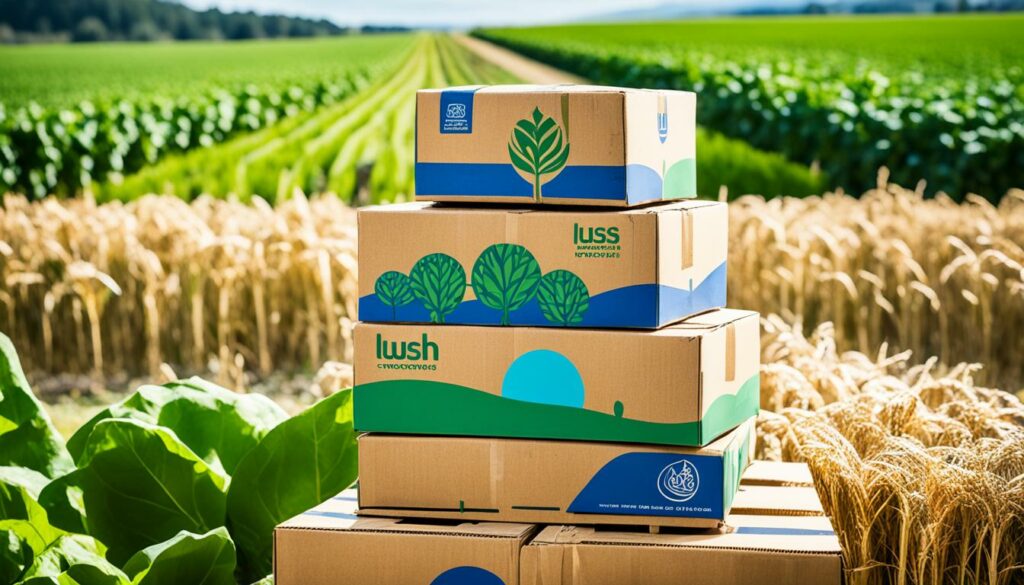
Moving to sustainable packaging materials is crucial. They lessen harm to the environment and push for us to reuse items. Take cardboard, it’s eco-friendly because we can renew and reuse it. And softwood pallets are better than hardwood ones because they’re lighter and cheaper.
Choosing green distribution in agriculture brings many good things. It saves money, makes business smoother, and reduces risks. Use a just-in-time delivery system to cut down the need for big warehouses. This stops products from sitting unused.
Transporting products is the biggest strain on the environment in food supply chains. So, choosing eco-friendly ways to store goods is very important. It helps lower CO2 pollution and saves money. Plus, using ESG operational criteria supports bigger goals of sustainability and business success.
| Material | Sustainability | Cost-Effectiveness | Recyclability |
|---|---|---|---|
| Cardboard | High | Moderate | High |
| Softwood Pallets | Moderate | High | Moderate |
| Hardwood Pallets | Low | Low | Low |
It’s obvious that using sustainable packaging and smart ways to distribute items is key. With smart use of ESG operational criteria, agriculture can lead to a better, greener future.
As agriculture moves towards ESG, it must focus on how it treats farmworkers. This means ensuring they are paid fairly and work in safe places. These practices are key to being socially responsible and ethical in agriculture. They not only meet ESG goals but also make the workforce more ethical, productive, and happy.
Financial leaders in farming know how vital ethical labour is. About 70% of them say it’s crucial to pay fair wages and offer key benefits. This approach supports social responsibilities in agriculture, improving the lives of those in farming areas.
They also focus on keeping the workplace safe. By following strict safety rules, they lower the chances of farmworkers getting hurt. This not only protects farmworkers but also makes the job more productive and reliable.
The world of farming sees too much forced and child labour. In fact, this area accounts for 11% of the global modern slavery cases. So, CFOs play a big role in changing things for the better. They work towards treating all farmworkers fairly and keeping them safe.
By being socially responsible, the agriculture industry not only meets labour standards but also shows it’s ethical. This builds a stronger business that investors can trust.
Farming is closely linked to our local areas. It offers jobs to about a quarter of people worldwide. It also brings in a lot of money. This is why support from the community is crucial for farming to grow sustainably. I believe that leaders in finance within farming, known as CFOs, are key. They drive investments that strengthen ties with communities. These investments also help the farming sector stay strong over time.

Investing in local buildings and systems is key for farming to connect with society. Better roads, water systems, and places to keep crops can boost how much we produce and reach more markets. This boosts local economies and keeps a reliable number of workers available. It starts a positive cycle of improvement in our areas.
Helping with schooling and health is crucial in farming. Education makes sure people know the best ways to farm without harming the land. Good health care looks after those in farming, keeping them well. Support in these areas helps us meet our societal duties. It also sets the path for farming communities to grow in a strong and lasting way.
“Farming’s strength is tied to how well the communities around it do. So, boosting buildings, schools, and health services isn’t just good. It’s also smart for making sure our communities last.”
Being serious about these things builds a dependable and healthy working group. It’s the heart of why farming can be strong and last. Making sure farming works well for everyone is key to our long-term achievements. It builds a place where everyone can do well.
| Key Metrics | Current Status | Target |
|---|---|---|
| Employment in Agriculture | 25% of Global Population | – |
| Annual Revenue | USD 10 Trillion | – |
| Reduction in Environmental Impact | $3 Trillion Annually | – |
| Investment in Agricultural Technologies | $5 Billion in 2022 | – |
| Net Zero Carbon Emissions | – | By 2050 |
| Energy Use Reduction | -4.2% | 15% by 2025 |
| Water Use Reduction | -16.07% in High-Risk Areas | 20% by 2025 |
Keeping consumers healthy is our top priority. It’s key to building trust in our products. We promise to follow strict consumer safety standards. We care about the quality of what we make and how safe it is.
We stick to the rules for safe food making (ESG compliance). This keeps our products well-regarded in the market.
| Year | Sustainability Goal | Achievement |
|---|---|---|
| 2022 | 75% sustainably sourced tomatoes | Achieved |
| Prior to 2022 | 56% sustainably produced tomato volumes | Achieved |
| 2025 (goal) | 100% sustainably sourced tomatoes | In Progress |
Kraft Heinz is serious about ESG compliance. We’ve set up ways for our suppliers to farm responsibly. These measures help us meet high consumer safety standards. They ensure we make food the right way.
Our commitment to these rules is good for people and shows our green efforts. It proves we’re serious about responsible food production.
Every part of our work respects consumer safety standards. This focus shapes our future. We make sure our goods are safe and good. That’s how we stay at the top in food making.
In agriculture, it’s key to have a diverse and inclusive environment. This shows a focus on being socially responsible and drives innovation. Companies with diverse teams often outperform others. This mix brings new ideas and better ways to solve problems in farming.
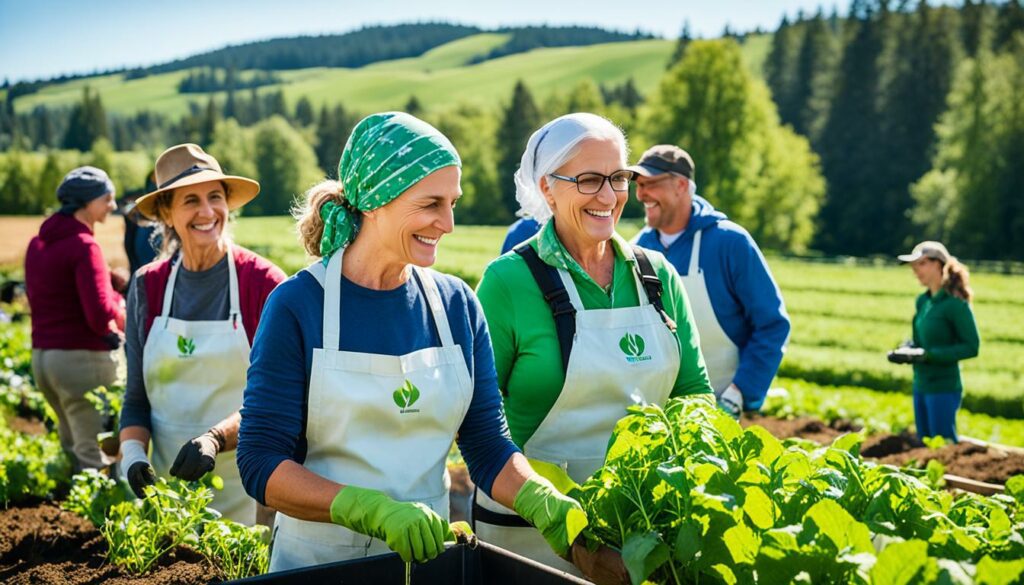
Creating a team that represents society is critical. It means connecting with all kinds of people. This sharing of views improves decision making and makes the sector more welcoming. Also, mentoring helps support and advance those who might not usually get a chance.
Being honest about how diverse and inclusive a company is, is vital. It shows you’re serious about these issues and attracts like-minded job seekers. Young people especially want to work for companies improving the world. So, sharing your progress in these areas is important.
It’s important for agribusinesses to have leaders from different backgrounds. This sets them up for success in the long run. Leaders who take on inclusion and set clear goals are key. Including everyone at the top makes the whole organisation more inclusive.
Supporting a range of suppliers is just as important. This too shows a real commitment to diversity. It can even attract investors who are serious about environmental, social, and governance issues.
| ESG Diversity Criteria | Impact on Farming Operations |
|---|---|
| Diverse Workforce | Boosts profitability and innovation through varied perspectives. |
| Leadership Inclusion | Feeds a culture of inclusivity and enhances strategic position. |
| Mentorship Programs | Supports advancement of underrepresented employees, contributing to talent retention. |
| Community Engagement | Fosters better industry understanding and stakeholder relations. |
| Transparent Reporting | Ensures accountability and attracts values-driven candidates. |
The agricultural world is always changing. Pushing for more diversity and inclusion is crucial for its future. By making diversity part of their daily life, agribusinesses get stronger and more strategic.
Looking at ESG farming initiatives, one sees the need for different focuses. Farmers must look at *environmental*, *social*, and *governance* principles. Heinz is a top example, working hard in sustainable farming. 75% of their ketchup tomatoes in 2022 met green standards, showing their strong green commitment.
Heinz earned a ‘FSA Silver’ for their farming practices’ sustainability, as measured by SAI Platform. This shows their ethics in food production and big push for sustainability. Even before checks, 56% of their tomatoes met green standards, showing ongoing work.
They’re deep in several projects, like ESG classes in Egypt and linking with Assan Foods for sustainable methods. They’ve partnered with reNature Foundation too, for the Save our Soils Program. These moves fit well with ESG efforts, showing strong teamwork.
Heinz’s test with cover crops in California is a success. It doubled in size by 2022. Such steps towards ESG not only make farming greener but also set a path for long-lasting farming.
Money in green land use makes farming strong, through practices like crop rotation and agroforestry. Saving water and helping small farmers are also key. This creates fair and green food.
ESG farming is all about looking after our resources, using good work practices, and having strong rules.
Sharing details and being responsible is key, making investors and buyers trust you. New tech, like precise farming, blockchains, and AI, help. They use resources better and harm the environment less.
ESG investing has tough parts, like measuring how well you do and getting everyone to agree. Companies like Edible Garden show how. They use advanced farming methods and aim for zero waste. This cuts their greenhouse gas release and raises their crops.
ESG farming is all about working together for better and fairer farming. Everyone in the industry joins in, using strong guides and new ideas.
ESG in agriculture is changing the game. Agriculture causes lots of deforestation and puts many species at risk. So, it’s vital to farm in a way that doesn’t harm the planet.
One out of every eight people around the world works in agriculture. This shows how important ESG farming is for the future. Actions like using less fertiliser and turning to renewable energy are making a big difference. Plus, investing in more farming in cities is also happening.
By the 2030s, sustainable farming could be worth a huge USD 1.5 trillion. This change could bring big wins for the economy and the environment. The key is to keep going forward and to lead with smart plans. It’s not just about saving the Earth from farming harm. It’s about making sure farming helps people and the planet for a long time. Everyone working together can build a better, fairer, and green farming future.
ESG farming means using eco-friendly, fair, and accountable ways in agriculture. It focuses on green farming, fair food making, and following rules to help save the planet and care for people.
ESG is vital in farming as it deals with big issues like global warming and loss of nature. It also ensures workers are treated right and communities are looked after. It helps farms meet laws, meet what buyers want, and make food the right way.
CFOs are important for ESG by linking it to the money side of things. They push for green practices and use cash for better tech to save resources. They help in new ideas, lower risks, and make those who invest feel secure. This is all about making money for the long haul and making farming strong through ESG.
To tackle climate change, farms need to grow plants that can bear dry times. They must build systems to cope with floods and have flexible ways of farming. These steps keep farms productive no matter the weather, and they are key in ESG farming.
Sustainable farming is about using water wisely with methods like drip irrigation. It’s also about keeping the soil healthy by rotating crops and not tilling too much. These ways keep the land fertile for a long time and cut down bad effects on the environment.
Biodiversity helps nature stay healthy and supports farming that goes on for years. CFOs can help by backing efforts to control pests through nature. These efforts mean a healthier environment and more money from better crop pollination and pest control.
Farms can make less impact on the planet by using clean energy and planting trees. These ways fight climate change and can even bring in money through selling off saved carbon. They are vital in ESG farming.
Using less energy is good for the Earth and the farmer’s wallet. Investing in tech that uses energy better saves money and helps in ESG aims. It makes farms sustainable and profitable.
Turning waste into something good for the Earth helps the soil and makes farms last. Cutting pollution is about using tech like precision farming and reusing food leftovers. These actions are good for nature and part of ESG.
Choosing green packing and smart ways to send out food lowers its carbon cost. This is key for full ESG work, making sure farming is both green and ethical in running its business.
Pay and work safety are at the heart of the caring side of ESG. They build a good team spirit, keep the farm’s right to work going, and help farm workers and the places they live in.
Helping build local roads, and backing schools and clinics, makes communities stronger. This keeps farming social promises, grows a steady workforce, and makes local economies tough.
Skilled checks, following food rules, and clear labels protect what we eat. These steps keep people trusting and choosing farm products, keeping farming’s good image safe.
Mixing people at all work levels shows farming cares for everyone and finds new ways to do things. It makes sure different views are heard, meets varied needs, and lifts ethical bars higher.
ESG in farming means lots of green, fair, and solid practices. It includes saving resources, being fair with workers, putting money into clean energy, and having good rules. Everyone from CFOs to folks in the business and its friends work together on this.